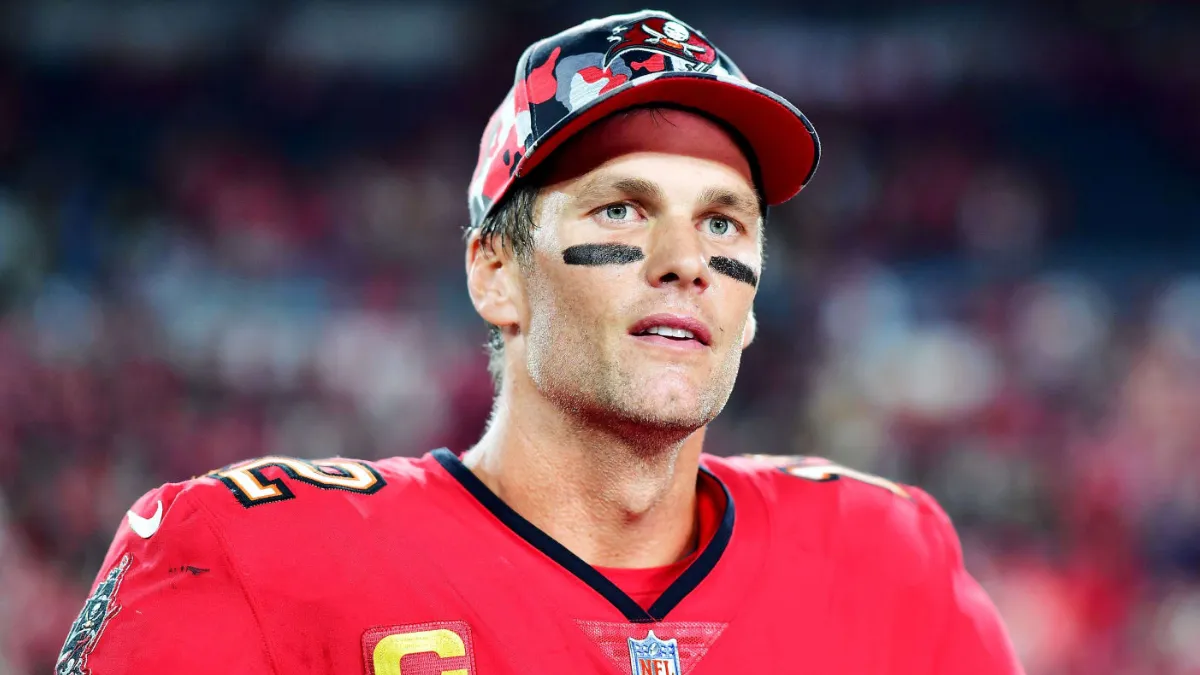Every dynasty begins with a doubt.
In 2000, Tom Brady was a lanky kid from Michigan, drafted 199th overall, a pick so unremarkable that ESPN barely cut away from commercials to mention it. And yet, from that moment of obscurity, the NFL’s most celebrated underdog quarterback began carving out his place in immortality.
“How does a lanky kid from Michigan rewrite NFL history?” It’s a question fans still ask, because nobody — not scouts, not coaches, not even Brady himself — imagined the trajectory ahead.
On draft day, Brady admitted with disarming honesty: “I was crying. I thought I was never going to play football again.” That raw vulnerability only makes his ascent more mythic.
Fast-forward to his first Super Bowl, when a wide-eyed Brady, barely in his second season, stood under the blinding lights in New Orleans and shocked the St. Louis Rams. Do you remember where you were that night? Millions do — because it was the night a dynasty was born, and an overlooked Michigan man became the face of NFL immortality.
How Brady’s Michigan Years Shaped His NFL Mindset
Before he became a New England legend, Tom Brady was just another Michigan Wolverines QB fighting for snaps. From 1996 to 1999, he spent much of his career buried on the depth chart, often criticized for being “too slow” or “too average” to lead at the NCAA level.
Yet even as a backup, Brady kept grinding. By his senior year, he had started 25 games, thrown for over 4,600 yards, and led the Wolverines to an Orange Bowl victory.
It wasn’t flashy compared to Michigan peers like Drew Henson, who often stole headlines, but it revealed a relentless mindset: patience, persistence, and preparation.
Former Michigan coach Lloyd Carr once said Brady’s strength was simple: “He never quit on himself, even when others did.” Fans on old Wolverines forums echo this, remembering Brady as the guy “who never looked like the best athlete but always looked the most prepared.”
What year did Tom Brady play at Michigan? 1996 through 1999.
Draft Day 2000: The 199th Pick That Changed History
Why Was Tom Brady Drafted So Late?
In the 2000 NFL Draft, Tom Brady wasn’t exactly a scout’s dream. Reports labeled him “slow-footed” with an unremarkable build and questionable arm strength. His infamous combine photo — awkward, shirtless, and unimposing — became shorthand for why teams passed on him.
Six quarterbacks, including Chad Pennington and Marc Bulger, went ahead of Brady before New England finally took him with the 199th pick.
From today’s vantage point, the oversight feels surreal. Fans in 2025 scroll through that draft board in disbelief, wondering how the league’s future GOAT was nearly forgotten.
Brady himself has joked that every time he sees the combine tape, he still laughs — proof that scouting reports don’t always measure greatness.
The Patriots’ Gamble That Paid Off
The New England Patriots saw something others missed. Despite his sluggish 40-yard dash and average arm strength, Bill Belichick valued Brady’s football IQ and poise.
Robert Kraft later recalled: “He looked me in the eye and said, ‘I’m the best decision this organization has ever made.’ And he was right.”
The odds were staggering: fewer than 15% of sixth-round quarterbacks even make an NFL roster. Yet Brady not only stuck — he rewrote the sport’s history.
Think of it like the NFL’s Amazon story: a late-round “startup” that grew into a global empire.
What round was Tom Brady drafted in? 6th round, 199th overall.
Rise in New England: From Backup to Franchise Savior
How Drew Bledsoe’s Injury Changed Brady’s Life
September 23, 2001. The Patriots were trailing the Jets when linebacker Mo Lewis delivered a crushing sideline hit to starter Drew Bledsoe.
The stadium gasped as Bledsoe staggered off, blood in his lungs and season in jeopardy. Into the chaos jogged an untested backup — Tom Brady.
Few fans expected much; he’d barely taken meaningful snaps. But that moment marked the pivot.
Brady’s first start the following week against Indianapolis began a streak that would redefine the Patriots’ identity. What looked like a disaster for New England became the unlikely opening for football’s greatest career.
The First Super Bowl Triumph (2001 Season)
In February 2002, the unthinkable happened: Tom Brady, in just his second year, led the Patriots to a stunning Super Bowl XXXVI upset over the “Greatest Show on Turf” St. Louis Rams.
As the clock ticked down, legendary broadcaster John Madden cautioned, “Maybe the Patriots should just play for overtime.” Brady, calm amid the chaos, ignored the script.
He marched New England into field-goal range, setting up Adam Vinatieri’s game-winner. One fan later wrote on an early forum: “I’ve never seen a QB look so cool under that kind of pressure.”
When did Tom Brady win his first Super Bowl? 2001 season.
Building the Patriots Dynasty (2001–2018)
The Three Super Bowl Run (2001–2004)
What began as a Cinderella story quickly turned into a dynasty. Between 2001 and 2004, Brady and the Patriots captured three Lombardi Trophies in just four seasons, redefining consistency in the salary-cap era. Their blend of Belichick’s defensive genius and Brady’s clutch leadership created an NFL juggernaut that no one saw coming.
Patriots Super Bowls (2001–2004)
| Season | Opponent | Result | Score |
| 2001 | St. Louis Rams | Win | 20–17 |
| 2003 | Carolina Panthers | Win | 32–29 |
| 2004 | Philadelphia Eagles | Win | 24–21 |
The Comeback Years After a Decade Drought
After the 2004 win, the Patriots’ dynasty hit an unexpected lull. For nearly a decade, Brady and Belichick returned to the postseason year after year, but the ultimate prize eluded them.
Losses to the Giants in Super Bowls XLII and XLVI stung the most — both games slipping away in the final minutes.
The drought ended in 2014 with a dramatic win over Seattle, reigniting the dynasty.
But controversy soon followed: the Deflategate scandal, in which Brady was accused of using underinflated footballs, dominated headlines. He served a four-game suspension, only to return hungrier, winning three more titles before leaving New England.
How many Super Bowls did Tom Brady win with the Patriots? Six championships.
The GOAT Debate: Brady’s Rivalries & Records
Tom Brady vs. Peyton Manning: The Defining Rivalry
For over a decade, Sundays often meant one thing: Brady vs. Manning. Their matchups weren’t just games — they were cultural events, drawing record TV audiences.
Statistically, Brady held the upper hand, winning 11 of their 17 meetings and edging Manning in playoff duels. Yet Manning often bested him in MVP votes and regular-season numbers, creating a rivalry of contrasts: Brady the relentless winner, Manning the stat-sheet king.
Peyton himself once admitted, “If you can’t appreciate what Tom’s done, you’re missing out on football history.” Their duels defined an era, forcing each other to elevate, and in turn, shaping the NFL’s quarterback standard for years to come.
How Brady Redefined Longevity in the NFL
Brady’s dominance into his 40s wasn’t an accident — it was the product of his meticulous TB12 method: pliability training, a plant-heavy diet, and even that now-famous avocado ice cream.
Sports scientist Dr. Michael Joyner once noted, “Brady is redefining what we thought was possible for athletic longevity.”
His 22-year career shattered NFL records for passing yards and touchdowns, but the GOAT debate isn’t only statistical.
It’s cultural — Brady became the symbol of discipline, reinvention, and resilience in a league built on attrition.
Is Tom Brady the greatest QB of all time? Many say yes — because his longevity redefined the position itself.
Tampa Bay Rebirth: Proving Age is Just a Number
Why Brady Left New England for Tampa Bay
After two decades, six Super Bowls, and an unmatched dynasty, Tom Brady shocked the NFL in 2020 by leaving New England.
But it is not confirmed that a rift had grown between Brady and Bill Belichick — disagreements over contract length, roster input, and whether the 42-year-old QB could still deliver.
While Belichick was ready to plan for the future, Brady wanted to prove he still had plenty left. Tampa Bay offered weapons, flexibility, and faith.
The move wasn’t just a free-agency signing; it was a statement. Brady wasn’t done. And in true underdog fashion, he set out to prove it all over again.
Super Bowl LV – The Seventh Ring
In February 2021, Tom Brady silenced every doubt. At 43, he led the Tampa Bay Buccaneers to a decisive 31–9 victory over Patrick Mahomes’ Chiefs in Super Bowl LV.
CBS flashed the stat repeatedly: the oldest Super Bowl MVP in history.
For Tampa fans, it was redemption. For Brady, it was proof that reinvention works at any age. He brought swagger to a franchise long overlooked, turning skeptics into believers once more.
What team did Tom Brady retire with? The Tampa Bay Buccaneers.
Life After Football: Broadcasting, Business & Legacy
Fox Broadcasting Deal & Media Role
Retirement didn’t mean silence for Tom Brady. In 2022, Fox Sports stunned the industry by announcing a 10-year, $375 million contract with Brady to become its lead NFL analyst. Brady signed the biggest analyst deal in sports history.
For fans, the move promised something new — Brady’s unparalleled game IQ translated into broadcast storytelling. Industry insiders called it Fox’s answer to Tony Romo’s rise in the booth.
Whether he becomes a natural broadcaster or a polarizing presence remains to be seen, but the deal alone reinforced Brady’s magnetism. Even off the field, his voice remains as bankable as his arm once was.
TB12 Brand, Fitness Legacy, and Investments
Brady’s empire extends far beyond the broadcast booth. His TB12 brand — built on pliability training, recovery tools, and nutrition — has become a wellness blueprint for athletes and everyday fans alike.
He’s also launched Brady Brand apparel, dabbled in NFT ventures, and invested in everything from fitness startups to sports teams.
Philanthropy runs alongside profit. Through the TB12 Foundation, he’s awarded scholarships to young athletes who couldn’t otherwise afford elite training. It’s a softer echo of his own underdog journey.
Cultural Impact: Beyond the Numbers
Brady as a Symbol of Discipline and Longevity
Tom Brady’s legacy is defined by a paradox. On one hand, he lived amid indulgence — sprawling estates, supermodel glamour, luxury cars.
On the other hand, his daily life resembled that of a monk: strict diets, early bedtimes, relentless training. That duality fascinated fans and critics alike.
To some, he embodied the aspirational dream — proof you could “have it all.” To others, his avocado ice cream and pliability routines felt obsessive.
Yet together, those extremes created the blueprint for longevity. Brady wasn’t just playing into his 40s; he was rewriting the standard for how long greatness could last.

Influence on Younger QBs and NFL Training Standards
Tom Brady’s influence reaches far beyond his own stat line — it reshaped how the next generation trains.
Patrick Mahomes once admitted, “I study how Brady prepares because that’s the standard for longevity.” Joe Burrow echoed it, praising Brady’s ability to “always reinvent himself.”
Younger QBs embraced pliability training, strict nutrition, and mental focus because Brady proved discipline could outlast pure talent.
Even fan culture shifted; Instagram often buzzed with side-by-side posts comparing Brady’s tunnel-walk suits to GQ covers, proof of his pop-culture crossover.
Peer Comparisons: Brady Among NFL Legends
Every NFL generation crowns its quarterback king. For the 1980s, it was Joe Montana. The 2000s saw Peyton Manning rewrite record books. And then came Tom Brady, blending both legacies into something larger — dominance measured not just in numbers but in cultural resonance.
Quarterback Comparison
| Quarterback | Super Bowls Won | MVP Awards | Career Length |
| Tom Brady | 7 | 3 | 22 years |
| Joe Montana | 4 | 2 | 16 years |
| Peyton Manning | 2 | 5 | 18 years |
Statistically, Manning’s five MVPs stand unmatched. Montana’s four perfect Super Bowl runs remain iconic. Yet Brady’s seven rings and unmatched longevity place him in a league of his own.
But greatness isn’t only about trophies. Brady became a global brand, a fashion magazine cover subject, and the face of an NFL era.
Montana stayed a West Coast legend; Manning became beloved for wit and commercials. Brady, meanwhile, became cultural shorthand for excellence.
Immortality Beyond the Gridiron
From a lanky Michigan backup fighting for reps to a 43-year-old hoisting his seventh Lombardi, Tom Brady’s story has always been bigger than football.
It’s a tale of reinvention, of proving doubters wrong, of building a life where discipline and luxury collided in a fascinating paradox.
Brady didn’t just win games; he became a cultural touchstone. He graced GQ covers, inspired younger quarterbacks, and turned “pliability” into a household word.
Even his missteps — Deflategate, free agency drama — became part of the mythology.
And that draft-day image, the overlooked 199th pick, still lingers as the greatest reminder: greatness can start in doubt.
So the question now isn’t whether Brady is the GOAT — it’s what his immortality means beyond the gridiron.
FAQs About Tom Brady’s Career
What year did Tom Brady retire?
Tom Brady announced his retirement in February 2023, officially closing out a 23-season career that spanned the New England Patriots and Tampa Bay Buccaneers.
How many Super Bowls has Brady won?
Tom Brady won seven Super Bowls in total — six with the New England Patriots and one with the Tampa Bay Buccaneers — the most by any NFL player in history.
What is Tom Brady’s net worth in 2025?
As of 2025, Tom Brady’s net worth is estimated at around $300 million, fueled by NFL contracts, endorsements, broadcasting deals, and his TB12 business ventures.
Did Tom Brady ever lose a Super Bowl?
Yes. Brady lost three Super Bowls — twice to the New York Giants (2007, 2011) and once to the Philadelphia Eagles (2017) — despite his otherwise unmatched record.
Nishant Wagh is the founder of The Graval and a seasoned SEO and content strategist with over 15 years of experience. He writes with a focus on digital influence, authority, and long-term search visibility.















2 thoughts on “Tom Brady Career Timeline: From Michigan to NFL Immortality”